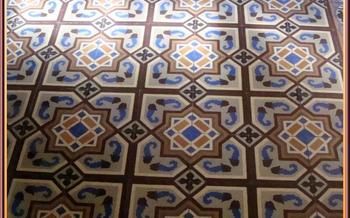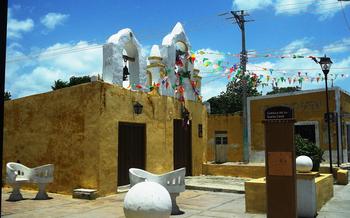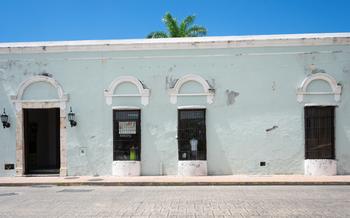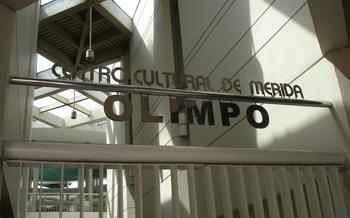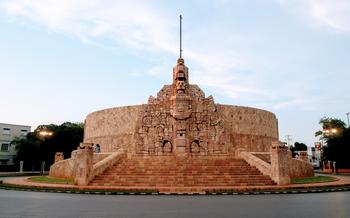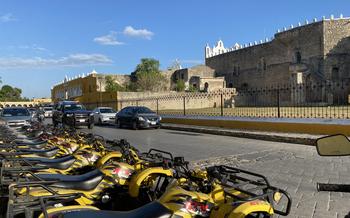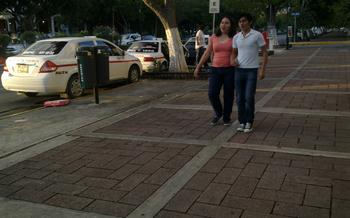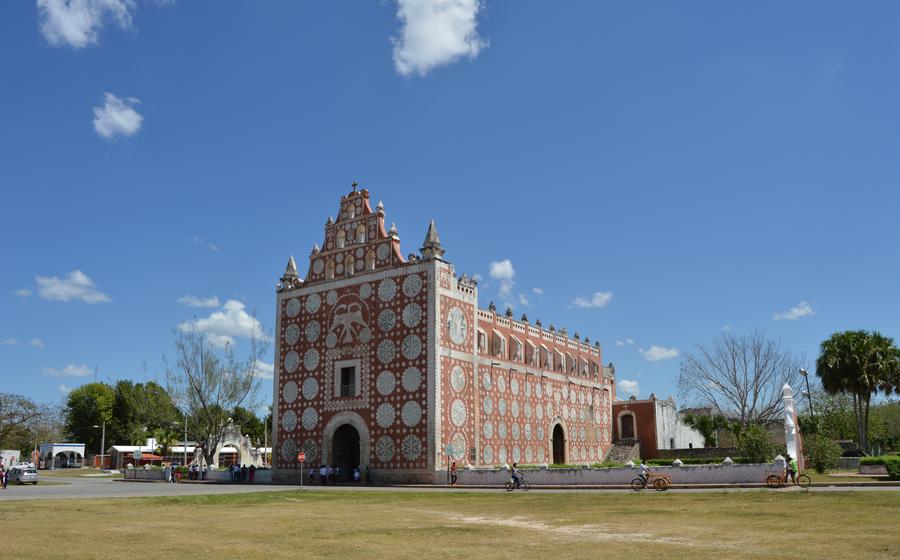
Templo de Santo Domingo
- Templo de Santo Domingo: A Majestic Colonial Marvel
- Historical Importance: A Legacy of Faith and Culture
- Intricate Altars: Masterpieces of Religious Art
- Museum of Mayan Culture: Unveiling Ancient Civilizations
- Guided Tours: Exploring History and Art
- Accessibility for Visitors: Ensuring Inclusivity
- Respecting Local Customs and Traditions
- Dress Code and Attire: Appropriate Clothing for Sacred Spaces
- Plan Your Visit: Tips for a Smooth Experience
- Souvenirs and Handicrafts: Unique Treasures to Take Home
- Nearby Attractions: Exploring the City's Treasures
- Insider Tip: Unforgettable Sunrise Views
Templo de Santo Domingo: A Majestic Colonial Marvel
In the heart of Mer's rich history and vibrant culture. Constructed in the 16th century by Franciscan missionaries, this architectural masterpiece has played a pivotal role in the religious and cultural development of the region. Blending Spanish Colonial, Neoclassical, and Mayan elements, the temple's grandeur captivates all who behold it. Its soaring bell towers, intricate facade, and ornate interior leave visitors in awe of its beauty and historical significance.
One local resident, Maria, shared her perspective on the temple's allure: "The Templo de Santo Domingo is more than just a building; it's the soul of our city. Its presence reminds us of our roots, our faith, and our cultural heritage. Whenever I pass by, I can't help but pause and admire its magnificence."
As you explore the temple, you'll discover a treasure trove of artistic wonders, including intricate altars adorned with gold leaf and colorful frescoes depicting biblical scenes. Its museum, the Museo de la Ciudad de Mérida, houses a fascinating collection of Mayan artifacts, providing a glimpse into the ancient civilizations that once flourished in this region.
Whether you're a history buff, an art enthusiast, or simply someone seeking tranquility, the Templo de Santo Domingo is a must-visit destination in Merida. Prepare to be captivated by its architectural splendor, immerse yourself in its rich history, and leave with a newfound appreciation for the cultural heritage of Mexico.
Historical Importance: A Legacy of Faith and Culture
The Templo de Santo Domingo stands as a testament to the profound religious and cultural heritage of Merida. Constructed by the Franciscans in the 16th century, its origins are intertwined with the city's own foundation. The temple played a pivotal role in the spread of Catholicism throughout the Yucatan region, becoming a center of religious devotion and cultural exchange.
Within its walls, countless souls have found solace, sought guidance, and celebrated their faith. The temple has borne witness to countless baptisms, marriages, and other significant life events, leaving an indelible mark on the hearts and minds of the faithful. Its enduring presence has helped shape the city's cultural identity, fostering a deep sense of community and belonging among its residents.
Anecdote:
In the heart of Merida, resides an elderly woman named Doña Maria. Her eyes twinkle with wisdom and her smile radiates warmth as she recounts her cherished memories of the Templo de Santo Domingo. In her youth, she would often accompany her grandmother to early morning mass, her tiny hand clasped tightly in hers. The scent of incense mingled with the sweet melodies of the choir, creating an atmosphere of reverence that filled her young heart with awe.
Over the years, Doña Maria witnessed countless weddings, christenings, and processions within the temple's sacred walls. Each occasion was marked with joy, tears, and the unwavering faith that bound the community together. For her, the Templo de Santo Domingo was more than just a religious edifice; it was the embodiment of Merida's rich spiritual heritage.
Intricate Altars: Masterpieces of Religious Art
The Templo de Santo Domingo is home to several stunning altars that showcase the artistic and religious heritage of Merida. The main altar, known as the Altar Mayor, is an elaborate masterpiece that took over 10 years to complete. It features intricate carvings, sculptures, and paintings depicting scenes from the life of Jesus Christ and the Virgin Mary. Other significant altars include the Altar de la Virgen de los Remedios, dedicated to the patron saint of Merida, and the Altar de San José, which features a beautiful statue of Saint Joseph.
The altars are not just visually stunning but also hold deep religious and cultural significance. They are adorned with symbols and iconography that tell stories of faith, hope, and devotion. For example, the Altar Mayor features a pelican feeding its young with its own blood, symbolizing the sacrifice of Christ for humanity. The altars are a testament to the artistry and craftsmanship of the Maya and Spanish artisans who created them. They continue to inspire awe and devotion in visitors from all over the world.
Anecdote:
During a guided tour of the temple, I had the opportunity to speak with a local woman who shared a touching story about one of the altars. She told me that her grandmother had been praying at the Altar de la Virgen de los Remedios for many years, asking for a miracle. One day, her grandmother's prayers were answered when she was healed from a serious illness. In gratitude, she donated a beautiful gold necklace to the altar, which is still displayed there today.
Museum of Mayan Culture: Unveiling Ancient Civilizations
Housed within the compound of the Templo de Santo Domingo, the Museo de la Cultura Maya is a treasure trove of ancient artifacts and exhibits that shed light on the rich history and legacy of the Mayan civilization. The museum's collection boasts an impressive array of sculptures, pottery, textiles, and other relics, providing visitors with a glimpse into the lives, beliefs, and artistry of this remarkable civilization.
Among the highlights of the museum's displays are intricate stone carvings, depicting Mayan gods, rulers, and scenes from their daily lives. Visitors can also marvel at the delicate and colorful pottery, showcasing the Mayan mastery of ceramics. The museum's textile collection features intricately woven fabrics, adorned with vibrant designs and symbols that hold cultural and religious significance.
Anecdote:
During a visit to the Museo de la Cultura Maya, I had the opportunity to speak with a curator who shared a remarkable story about a significant discovery made at the museum. In 2010, while examining a collection of Mayan pottery, the curator noticed an unusual symbol inscribed on a fragment of a ceramic vessel. After extensive research, it was revealed that the symbol represented a previously unknown Mayan deity associated with agriculture and fertility. This discovery shed new light on the religious beliefs and practices of the ancient Mayans, adding to our understanding of their complex and fascinating civilization.
Guided Tours: Exploring History and Art
To fully grasp the significance of the Templo de Santo Domingo, consider embarking on a guided tour. These tours, often led by experienced historians or art experts, provide an in-depth exploration of the temple's history, architecture, and religious significance. Guides weave captivating tales of the temple's construction, its role in the spread of Catholicism, and the cultural heritage it represents.
One such tour guide, named Maria, shared her passion for the temple with visitors, narrating stories of the indigenous Maya, the arrival of Spanish conquistadors, and the subsequent blending of cultures that shaped the temple's unique character. Her anecdotes about the temple's hidden symbols, intriguing legends, and remarkable restoration efforts brought the temple's past to life.
Guided tours offer a truly immersive experience, allowing visitors to connect with the temple's spirit and appreciate its intricate details. Whether you're an art enthusiast, a history buff, or simply curious about the allure of this sacred space, a guided tour will undoubtedly enhance your visit to the Templo de Santo Domingo.
Accessibility for Visitors: Ensuring Inclusivity
The Templo de Santo Domingo is committed to providing an inclusive and accessible experience for all visitors, regardless of their abilities. The temple features wheelchair ramps, accessible restrooms, and designated seating areas for visitors with disabilities. Additionally, the museum offers guided tours in sign language and audio descriptions of the exhibits for visually impaired visitors. The staff is also trained to assist visitors with disabilities and ensure that they have a comfortable and enjoyable experience.
Anecdote:
In a wheelchair, Maria, a visitor from Madrid, was eager to explore the Templo de Santo Domingo. She was pleasantly surprised to find that the temple was fully accessible, with ramps, elevators, and designated seating areas. Maria was able to navigate the temple independently and enjoyed the guided tour, which was provided in sign language. She was grateful for the inclusivity of the temple and the staff's willingness to assist her.
Respecting Local Customs and Traditions
When visiting the Templo de Santo Domingo, it's essential to be mindful of local customs and traditions to ensure a respectful and enjoyable experience. As a sacred religious site, the temple holds deep cultural and spiritual significance for the local community. Here are some guidelines to keep in mind:
-
Dress Code: Respectful attire is expected within the temple. Avoid wearing shorts, tank tops, or other revealing clothing. Cover your shoulders and knees when entering the temple.
-
Photography Etiquette: While photography is allowed in most areas of the temple, it's essential to be respectful of worshippers and avoid using flash or taking photos during religious ceremonies or events.
-
Noise and Disruptions: Be mindful of your voice level and avoid talking loudly or making excessive noise. Respect the tranquility of the temple and refrain from engaging in activities that may disturb other visitors or disrupt religious practices.
-
Respecting Traditions: Observe and learn about local customs and traditions related to the temple. Participate in rituals or ceremonies with respect and understanding, and avoid any actions that may be considered disrespectful or offensive.
Anecdote:
During my visit, I witnessed a touching moment when a local woman approached the altar of the Virgin Mary and lit a candle with deep devotion. She whispered a prayer, her eyes filled with tears. It was a reminder that this temple is more than just a historical site; it's a place of faith, hope, and spiritual connection for the local community.
Dress Code and Attire: Appropriate Clothing for Sacred Spaces
When visiting the Templo de Santo Domingo, it is important to dress respectfully, as it is a sacred religious site. While there is no strict dress code, visitors should aim for modest and conservative attire. Avoid wearing shorts, tank tops, or revealing clothing. Opt for lightweight, breathable fabrics that cover your shoulders and knees. For women, a long skirt or dress is appropriate, while men should wear long pants and a shirt or polo. By dressing appropriately, you can show respect for local customs and traditions, and ensure a positive and welcoming experience for all visitors.
Anecdote:
During my visit to the temple, I noticed a group of tourists who were turned away at the entrance due to their inappropriate attire. They were wearing shorts and tank tops, which were not considered respectful for the sacred space. The security guard politely explained the dress code and directed them to a nearby shop where they could purchase suitable clothing. After changing into more appropriate attire, they were allowed to enter the temple and experience its beauty and grandeur.
Plan Your Visit: Tips for a Smooth Experience
To make the most of your visit to Templo de Santo Domingo, proper planning is essential. Timing your visit is crucial; to avoid crowds and capture the temple's beauty in its best light, aim for an early morning visit. The golden hour, just after sunrise, casts a warm glow on the temple's facade, creating an ethereal atmosphere.
To ensure a smooth entry, consider purchasing tickets online in advance, especially during peak tourist seasons. This will save you time and allow you to bypass any queues. Additionally, remember that the temple observes specific visiting hours, typically from morning to early evening; check the official website or inquire with the local tourism office for the exact timings.
One insider tip to enhance your experience is to take advantage of the guided tours offered by the temple. These tours, often led by knowledgeable guides, provide a comprehensive overview of the temple's history, architecture, and cultural significance. The guides can share fascinating stories and anecdotes, bringing the temple's past to life.
Souvenirs and Handicrafts: Unique Treasures to Take Home
When exploring the area around the Templo de Santo Domingo, you'll stumble upon a treasure trove of authentic souvenirs and handicrafts that capture the essence of Merida. These locally crafted items, often made using traditional techniques passed down through generations, offer a tangible piece of the city's rich cultural heritage. From vibrant hand-woven textiles and intricate pottery to unique jewelry and wood carvings, there's something for every taste and budget.
Support local artisans by visiting the many shops and stalls near the temple. Engage in friendly conversations with the vendors, learn about their creative processes, and discover the stories behind each piece. Whether you're looking for a colorful souvenir to adorn your home or a meaningful gift for loved ones back home, you're sure to find something special here.
One such artisan, Maria, has been weaving beautiful textiles for over 40 years. Her stall is a riot of colors and patterns, each piece telling a unique story. As you admire her intricate designs, Maria shares tales of her ancestors and the traditions that inspire her work. You can't help but be captivated by her passion and dedication to preserving her cultural heritage.
As you browse through the offerings, remember that each purchase contributes to the livelihood of these skilled artisans and helps keep traditional crafts alive. By supporting local businesses, you not only take home a piece of Merida's charm but also contribute to the preservation of its cultural identity.
Nearby Attractions: Exploring the City's Treasures
In addition to the Templo de Santo Domingo, Mérida offers an array of captivating attractions that will further enrich your journey. Just a short stroll away, immerse yourself in the vibrant Plaza Grande, the city's heart, where you can admire the majestic Catedral de San Ildefonso, an architectural marvel dating back to the 16th century. As you wander through the city's historic center, don't miss the opportunity to explore other architectural gems, such as the Palacio de Gobierno, with its impressive murals depicting significant moments in Yucatán's history, or the Teatro José Peón Contreras, a stunning 19th-century theater renowned for its opulent interiors and cultural performances.
Beyond these iconic landmarks, Mérida boasts numerous museums that delve into the region's rich history and culture. The Museo de la Ciudad de Mérida, housed in a beautiful 19th-century mansion, offers a glimpse into the city's past through interactive exhibits and historical artifacts. For art enthusiasts, the Museo Fernando García Ponce showcases a diverse collection of modern and contemporary Mexican art, while the Museo de Antropología e Historia de Yucatán provides a fascinating journey through the ancient Mayan civilization.
Anecdote: A Serendipitous Discovery
During my visit to Mérida, I stumbled upon a hidden gem while exploring the city's backstreets. Intrigued by a colorful mural adorning a seemingly ordinary building, I ventured inside to discover a charming art gallery. The gallery showcased the works of local artists, each piece imbued with a unique perspective on the city's culture and traditions. As I perused the vibrant paintings and sculptures, I felt a profound connection to the soul of Mérida, a city that continues to surprise and enchant with its hidden treasures.
Insider Tip: Unforgettable Sunrise Views
Discover a Hidden Gem for a Breathtaking Sunrise Experience
For an unforgettable experience in Merida, make your way to the Templo de Santo Domingo just before sunrise. As the sky begins to lighten, find a spot on the temple's eastern side, where you'll witness a magical spectacle. The first rays of the sun will bathe the temple's facade in a warm, golden glow, creating an ethereal ambiance that will leave you spellbound.
The play of light and shadow on the intricate carvings and sculptures is truly mesmerizing. As the sun rises higher, the surrounding cityscape gradually comes to life, offering a panoramic view of Merida awakening. This is a moment of tranquility and beauty that will stay with you long after your visit.
To make the most of this experience, plan your visit accordingly. Aim to arrive at the temple around 6:00 AM, as the sun typically rises between 6:30 AM and 7:00 AM. You'll have ample time to find the perfect spot and soak in the serene atmosphere before the crowds arrive.
Remember to bring your camera to capture this magical moment, as the golden light creates an ideal opportunity for photography. Whether you're a seasoned traveler or a first-time visitor, this sunrise experience at the Templo de Santo Domingo is a must-do for anyone seeking an unforgettable memory of Merida.
